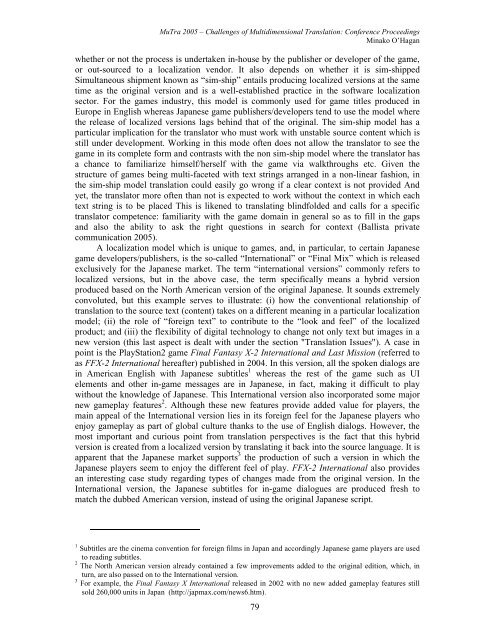Proceedings - Translation Concepts
Proceedings - Translation Concepts
Proceedings - Translation Concepts
Create successful ePaper yourself
Turn your PDF publications into a flip-book with our unique Google optimized e-Paper software.
MuTra 2005 – Challenges of Multidimensional <strong>Translation</strong>: Conference <strong>Proceedings</strong><br />
Minako O’Hagan<br />
whether or not the process is undertaken in-house by the publisher or developer of the game,<br />
or out-sourced to a localization vendor. It also depends on whether it is sim-shipped<br />
Simultaneous shipment known as “sim-ship” entails producing localized versions at the same<br />
time as the original version and is a well-established practice in the software localization<br />
sector. For the games industry, this model is commonly used for game titles produced in<br />
Europe in English whereas Japanese game publishers/developers tend to use the model where<br />
the release of localized versions lags behind that of the original. The sim-ship model has a<br />
particular implication for the translator who must work with unstable source content which is<br />
still under development. Working in this mode often does not allow the translator to see the<br />
game in its complete form and contrasts with the non sim-ship model where the translator has<br />
a chance to familiarize himself/herself with the game via walkthroughs etc. Given the<br />
structure of games being multi-faceted with text strings arranged in a non-linear fashion, in<br />
the sim-ship model translation could easily go wrong if a clear context is not provided And<br />
yet, the translator more often than not is expected to work without the context in which each<br />
text string is to be placed This is likened to translating blindfolded and calls for a specific<br />
translator competence: familiarity with the game domain in general so as to fill in the gaps<br />
and also the ability to ask the right questions in search for context (Ballista private<br />
communication 2005).<br />
A localization model which is unique to games, and, in particular, to certain Japanese<br />
game developers/publishers, is the so-called “International” or “Final Mix” which is released<br />
exclusively for the Japanese market. The term “international versions” commonly refers to<br />
localized versions, but in the above case, the term specifically means a hybrid version<br />
produced based on the North American version of the original Japanese. It sounds extremely<br />
convoluted, but this example serves to illustrate: (i) how the conventional relationship of<br />
translation to the source text (content) takes on a different meaning in a particular localization<br />
model; (ii) the role of “foreign text” to contribute to the “look and feel” of the localized<br />
product; and (iii) the flexibility of digital technology to change not only text but images in a<br />
new version (this last aspect is dealt with under the section "<strong>Translation</strong> Issues"). A case in<br />
point is the PlayStation2 game Final Fantasy X-2 International and Last Mission (referred to<br />
as FFX-2 International hereafter) published in 2004. In this version, all the spoken dialogs are<br />
in American English with Japanese subtitles 1 whereas the rest of the game such as UI<br />
elements and other in-game messages are in Japanese, in fact, making it difficult to play<br />
without the knowledge of Japanese. This International version also incorporated some major<br />
new gameplay features 2 . Although these new features provide added value for players, the<br />
main appeal of the International version lies in its foreign feel for the Japanese players who<br />
enjoy gameplay as part of global culture thanks to the use of English dialogs. However, the<br />
most important and curious point from translation perspectives is the fact that this hybrid<br />
version is created from a localized version by translating it back into the source language. It is<br />
apparent that the Japanese market supports 3 the production of such a version in which the<br />
Japanese players seem to enjoy the different feel of play. FFX-2 International also provides<br />
an interesting case study regarding types of changes made from the original version. In the<br />
International version, the Japanese subtitles for in-game dialogues are produced fresh to<br />
match the dubbed American version, instead of using the original Japanese script.<br />
1 Subtitles are the cinema convention for foreign films in Japan and accordingly Japanese game players are used<br />
to reading subtitles.<br />
2 The North American version already contained a few improvements added to the original edition, which, in<br />
turn, are also passed on to the International version.<br />
3 For example, the Final Fantasy X International released in 2002 with no new added gameplay features still<br />
sold 260,000 units in Japan (http://japmax.com/news6.htm).<br />
79
















